PsychNewsDaily Publishers
100 Summit Drive
Burlington, MA, 01803
Telephone: (320) 349-2484
PsychNewsDaily Publishers
100 Summit Drive
Burlington, MA, 01803
Telephone: (320) 349-2484
Cats scratch for various reasons, including claw maintenance and stress relief. Alternatives like wall-mounted scratchers and DIY boards can protect furniture while satisfying their natural instincts.
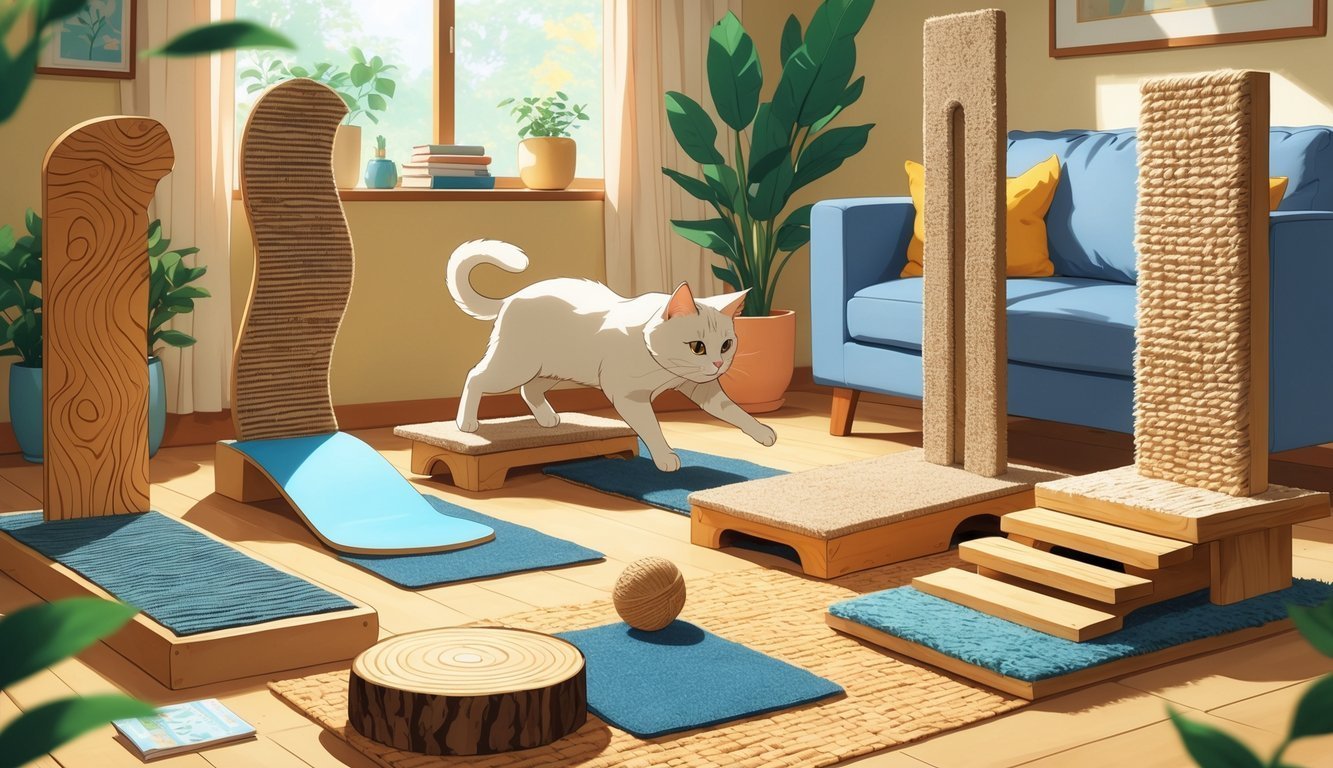
Cats scratch for all sorts of reasons—keeping claws healthy, marking their turf, stretching those long bodies. When a typical scratching post just isn’t cutting it, or you don’t have space for one, you’ll want some alternatives that actually mesh with your home and your cat’s quirks.
You can help your cat scratch in healthier ways and still save your furniture.
Let’s check out some practical options that go way beyond the usual post. You’ll see different surfaces, clever DIY ideas, and even small tools that can make a surprising difference.
Each one gives you a straightforward way to keep your cat happy without feeling frustrated.
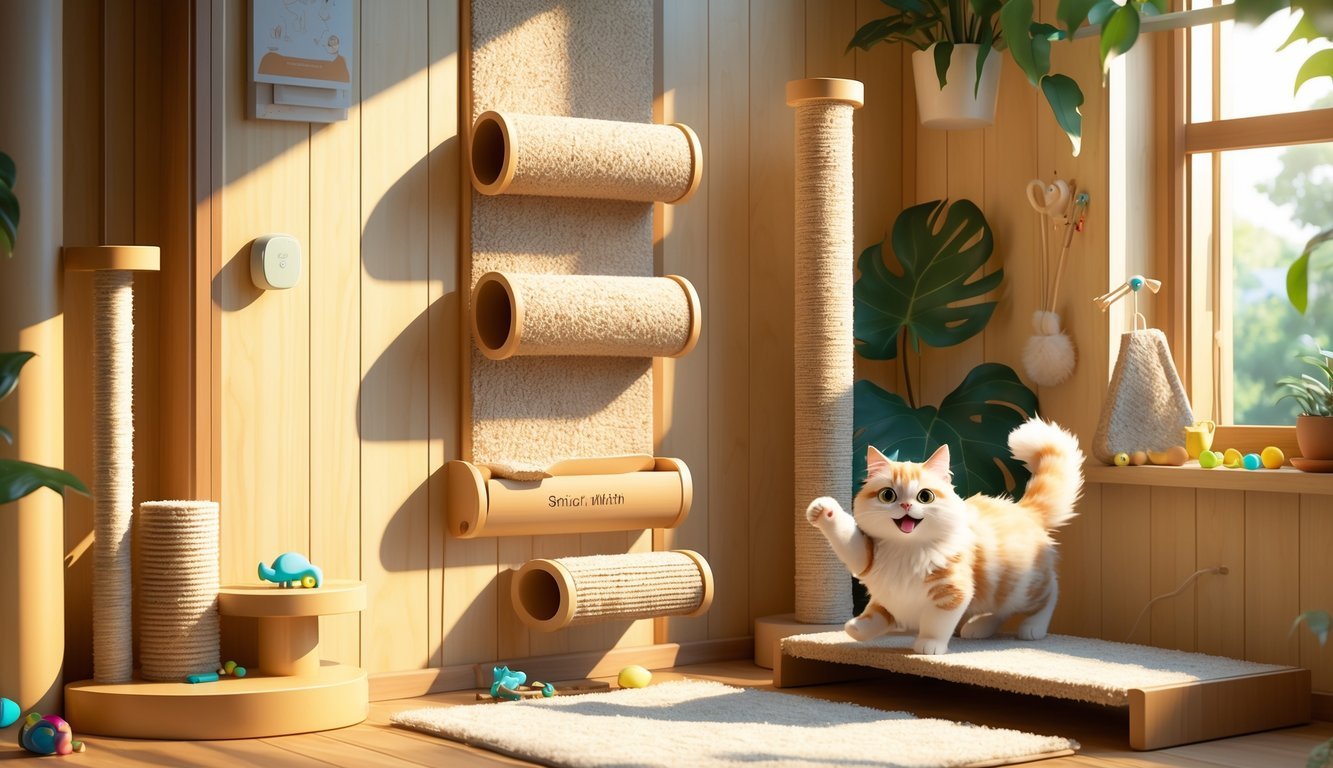
A wall-mounted sisal scratcher gives your cat a vertical place to dig in, and it doesn’t eat up your floor space. You can put it at the perfect height, so your cat can stretch out and really enjoy scratching.
Cats love sisal because it’s tough and textured. Unlike carpet or cardboard, sisal hangs in there longer and doesn’t fall apart as quickly.
When you hang a scratcher on the wall, you help save your furniture. Your cat gets a spot that feels natural—way better than the arm of your couch.
A lot of these designs let you swap out the scratching panel when it gets worn down. That means the setup will last a good while.
If you live in a small place, wall-mounted scratchers are especially handy. They keep things tidy and still give your cat the enrichment they crave.
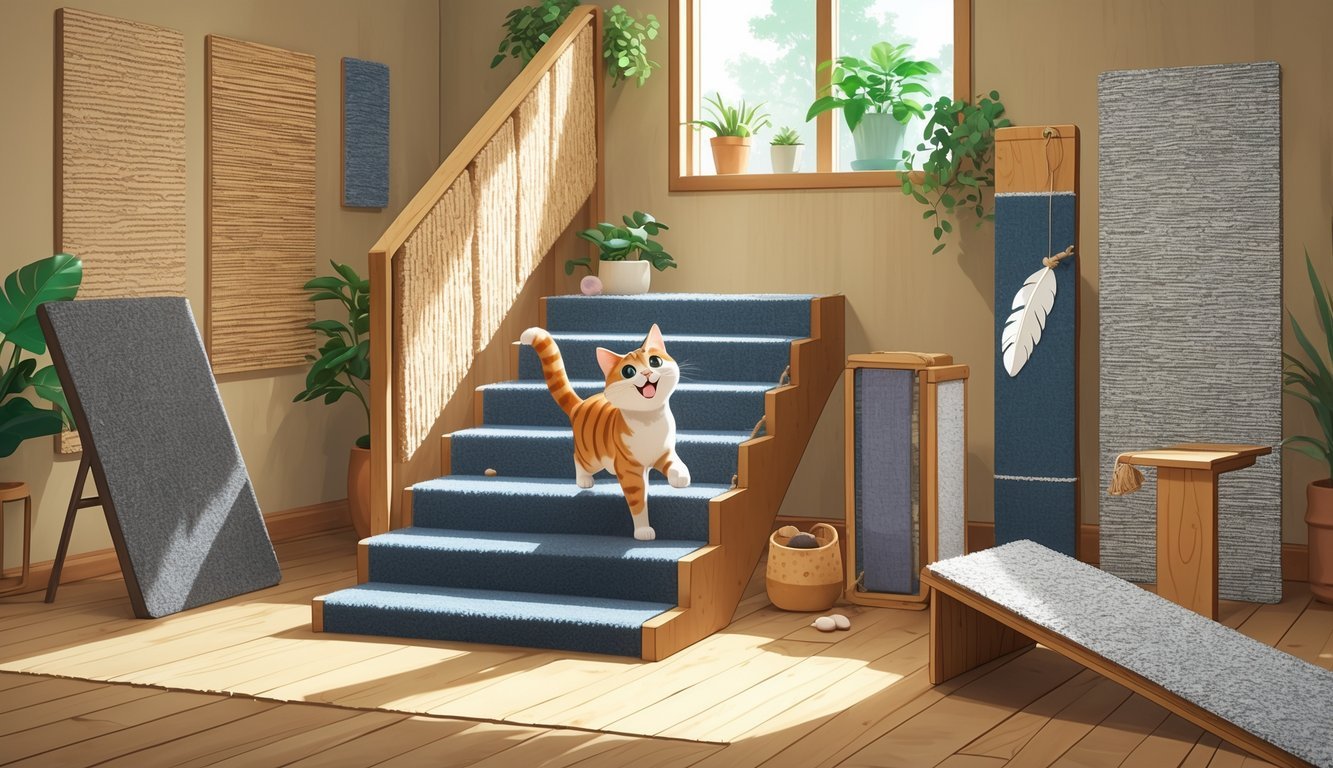
If your cat can’t resist carpet, why not turn part of your stairs into a scratching zone? The texture draws them in, and stairs offer a vertical stretch that really hits the spot.
You can use leftover carpet or sturdy stair mats—just pick something with a tight weave or a sisal-like feel. That way, it stands up to scratching and won’t unravel so fast.
Put the carpet on the bottom steps, especially where your cat already scratches. Giving them a clear target lowers the odds they’ll go after the rest of the stairs.
If your cat ignores the new spot, try a little catnip or a favorite toy to get their attention. Sometimes they just need a nudge.
A carpet stair scratcher makes sense if you’re short on space for a big post. It uses a spot your cat already likes, and it might just save your main carpet from getting wrecked.

Cardboard scratch pads offer a simple, satisfying spot for your cat’s claws. The rough feel is super appealing, and most cats warm up to them right away.
You’ll find them in all shapes—flat, angled, even lounge-style—so you can pick what fits your home.
Cardboard pads are light and easy to move. You can put them wherever your cat already likes to scratch, like near a window or the couch. Some come with catnip, which is always a bonus.
They’re easy on your wallet, too. Since most are made from recycled cardboard, they’re eco-friendly and cheap to replace when they get shredded.
Just remember, cardboard doesn’t last forever. You’ll need to swap them out more often than sisal or wood. Still, for the price and convenience, they’re hard to beat if your cat loves a good shred.
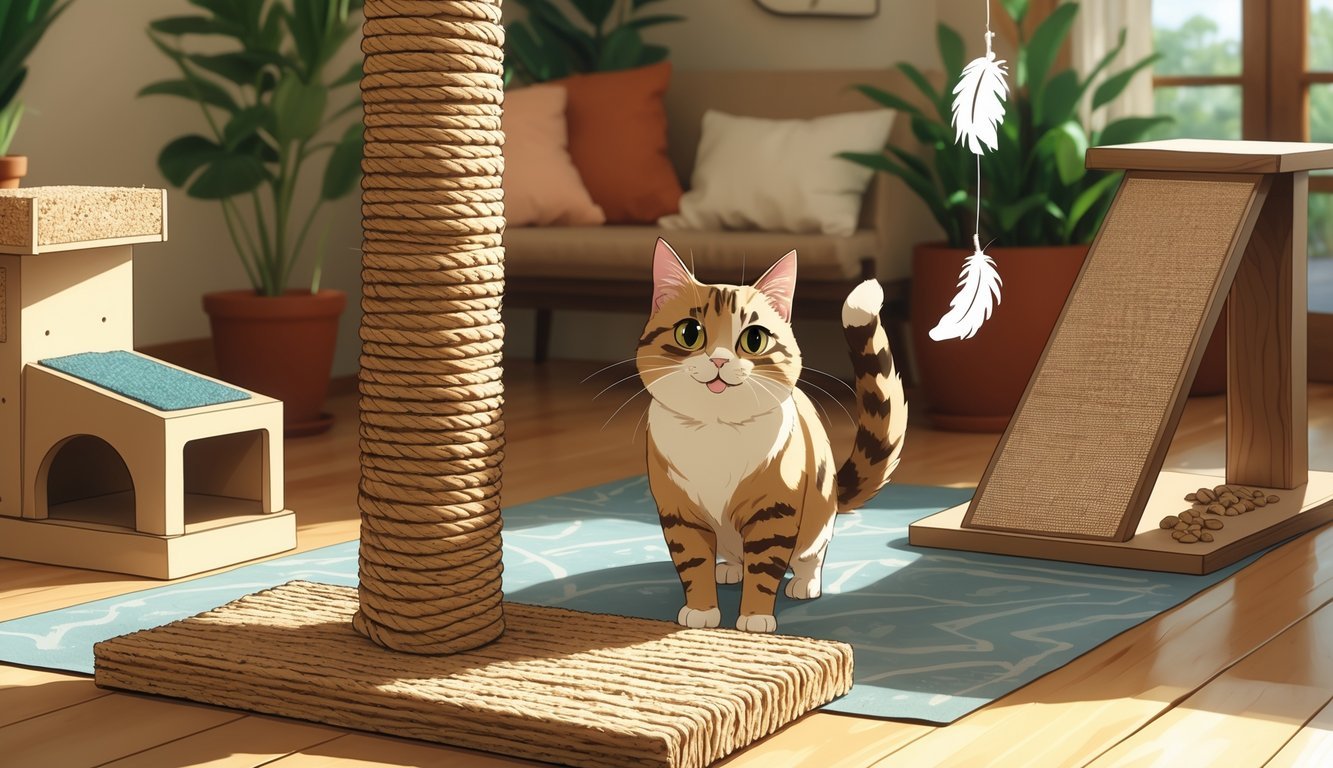
A sisal rope wrapped post gives your cat a sturdy, textured place to scratch. The rope’s roughness helps them shed old claw layers and keeps their nails in shape.
You can buy a post already wrapped, or make your own by winding sisal rope tightly around a wooden pole. Just make sure it’s secure so it doesn’t unravel.
Cats seem to love the grooves between the rope strands. Their claws grip nicely, which makes scratching extra satisfying.
Sisal rope holds up to a lot of abuse, though it will fray after heavy use. When that happens, you can just rewrap the post instead of buying a new one.
Put the post where your cat already hangs out, and you’ll have a better shot at saving your furniture. A sprinkle of catnip doesn’t hurt, either.

A soft fabric scratching mat gives your cat a flat place to scratch without hogging space. You can toss it on the floor, drape it over furniture, or even attach it to a wall or door.
A lot of cats like the different feel of fabric compared to rope or cardboard. The woven surface shreds in a way that’s satisfying, but it still hangs together for a while.
Try moving the mat around to see where your cat prefers it. Near their favorite nap spot usually works well.
Cleaning these mats is easy—just vacuum or shake out the mess. That keeps things tidier while your cat gets their scratch fix.
If your cat keeps going for the couch, put a fabric mat right next to it. It’s a good way to redirect scratching without a big battle.
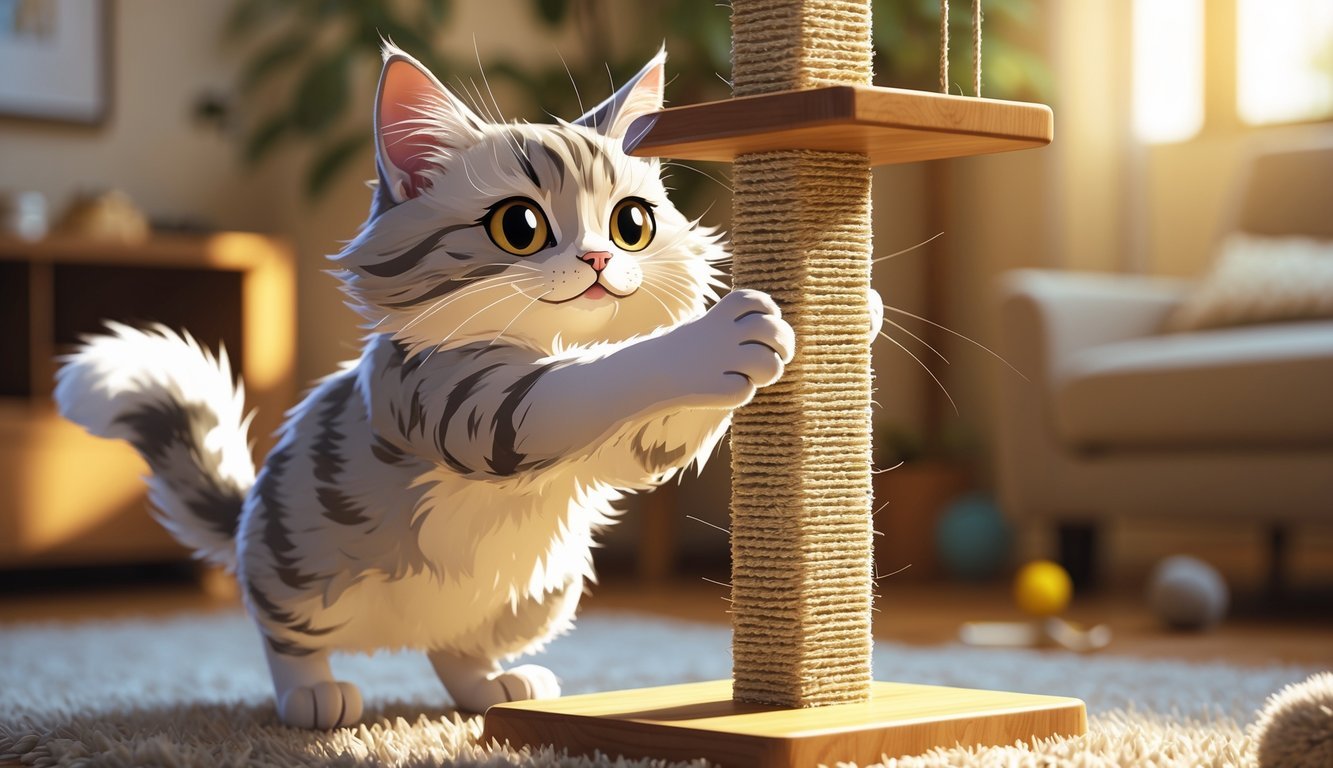
Cat scratching furniture like the Whisker Cat Tower lets your cat scratch and climb without wrecking your stuff. It acts as both a scratching surface and a piece of furniture, so your cat gets what they want and your couch gets a break.
The Whisker Cat Tower comes with built-in scratching areas. Cats naturally gravitate to it instead of your chairs or sofa, especially since it’s made with durable materials that can handle daily use.
It doubles as a climbing and lounging spot, which makes it even more attractive to your cat. They can scratch, stretch, and nap all in one place.
Put the tower where your cat already likes to hang out. If you add a little catnip or a favorite toy, that’ll help draw them in.
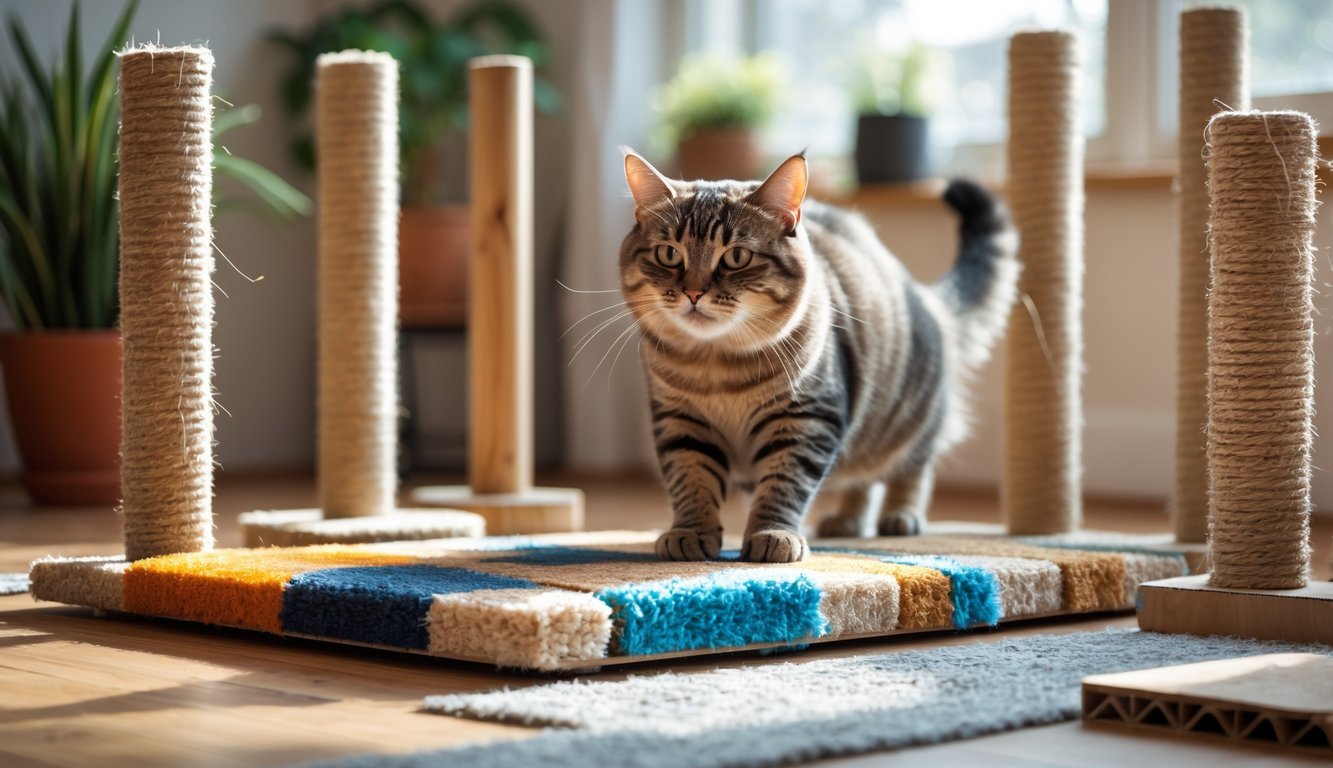
You can make a scratching board at home with a flat piece of wood and some leftover carpet. It’s budget-friendly and doesn’t take much time or skill.
It’s also a smart way to use up old scraps.
Cut the carpet to fit the board, then glue or nail it down tight so it won’t budge. Check for sharp edges or stray tacks before giving it to your cat.
You can lay the board flat, prop it against a wall, or mount it vertically. Each setup gives your cat a new angle to keep things interesting.
To get your cat interested, sprinkle some catnip on the board or put it near their favorite chill spot. When the carpet wears out, just swap in a new piece.
A homemade board lets you customize the size and shape, so it fits both your space and your cat’s habits. It’s a solid way to protect your furniture by offering a better alternative.
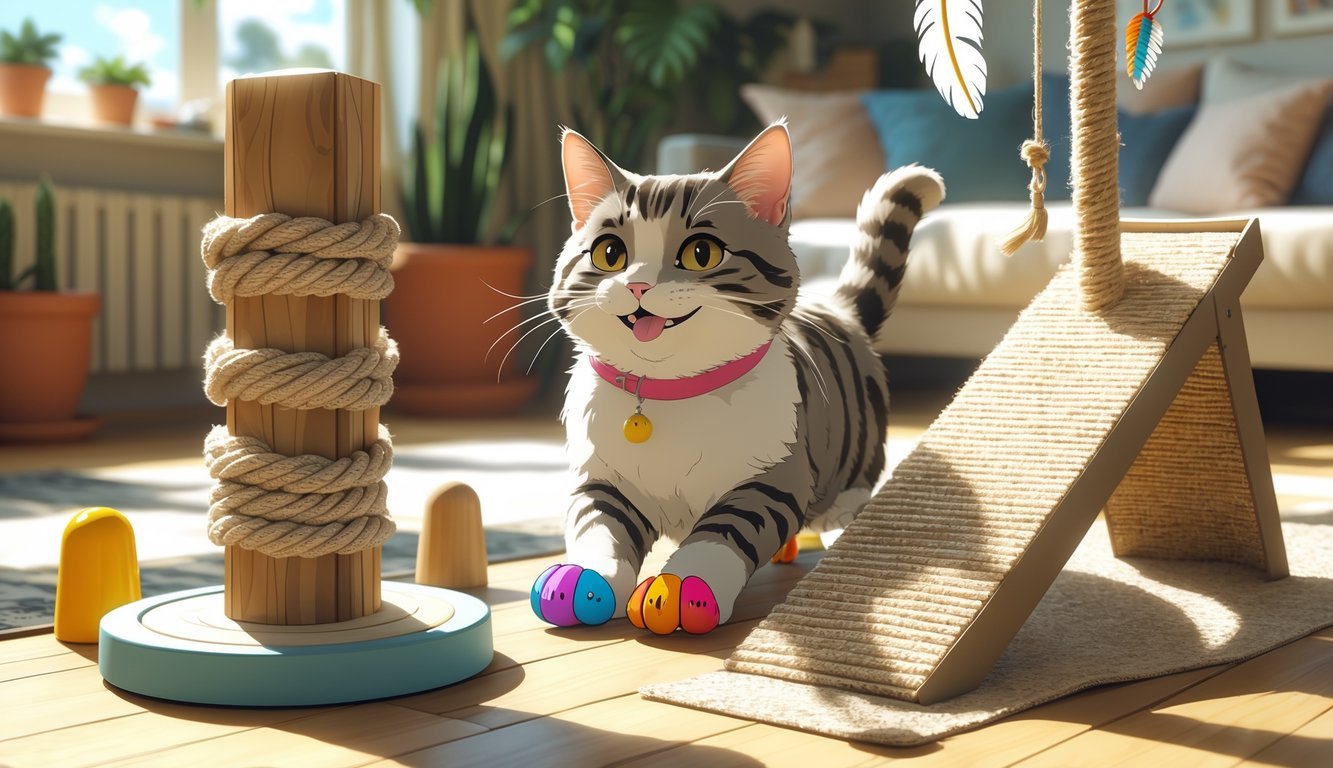
Nail caps are tiny, soft covers that go over your cat’s claws. They keep scratching from doing damage to your furniture, floors, or even your skin. You still let your cat keep their claws, which is way better than declawing.
You put the caps on with pet-safe glue, but it takes some patience. The right fit and a calm cat make things much easier. Most caps stay on for about four to six weeks before falling off as the nails grow.
Your cat can still stretch and scratch, but the sharp tips are covered, so the impact is way less. It’s a nice option if you want to protect your home and your cat at the same time.
Not every cat will love nail caps right away. Some might chew at them or act annoyed at first, so you may need to introduce them slowly.
Nail caps work best alongside scratching posts or regular nail trims. That way, your cat keeps healthy claws, and your stuff stays safe.
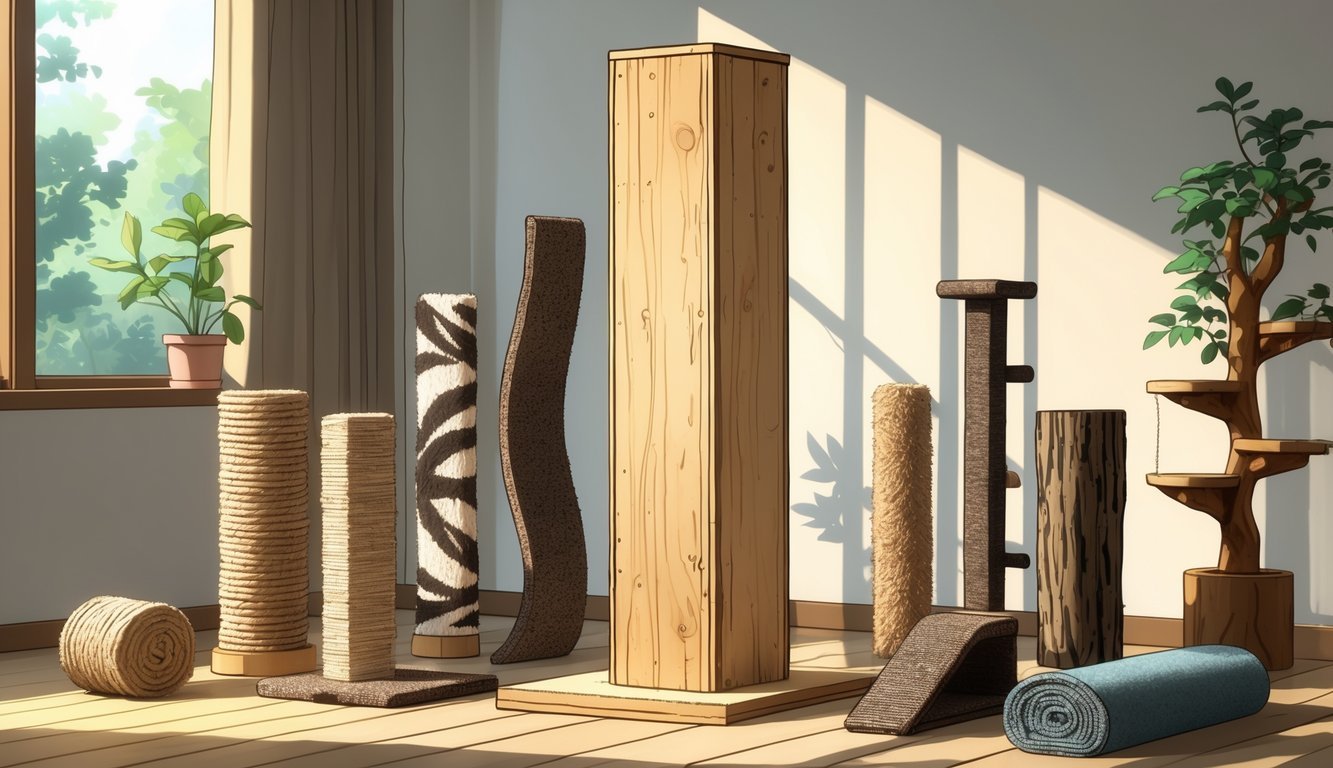
A vertical wooden scratching plank gives your cat a sturdy, wobble-free place to scratch. The solid feel lets them stretch all the way up, which they seem to love.
You can lean the plank against a wall or mount it securely so it stays put. This setup saves space and blends in better than a bulky post.
If you want, you can wrap the wood with sisal rope or fabric for extra texture. Or just leave part of the wood bare—some cats actually prefer that natural feel.
A wooden plank lasts longer than cardboard and won’t wear out quickly. If you want something durable that doesn’t need constant replacing, it’s a solid choice.
If your cat likes vertical scratching, this option gives them a good outlet and helps protect your furniture. It’s simple, strong, and easy to tweak for your space.
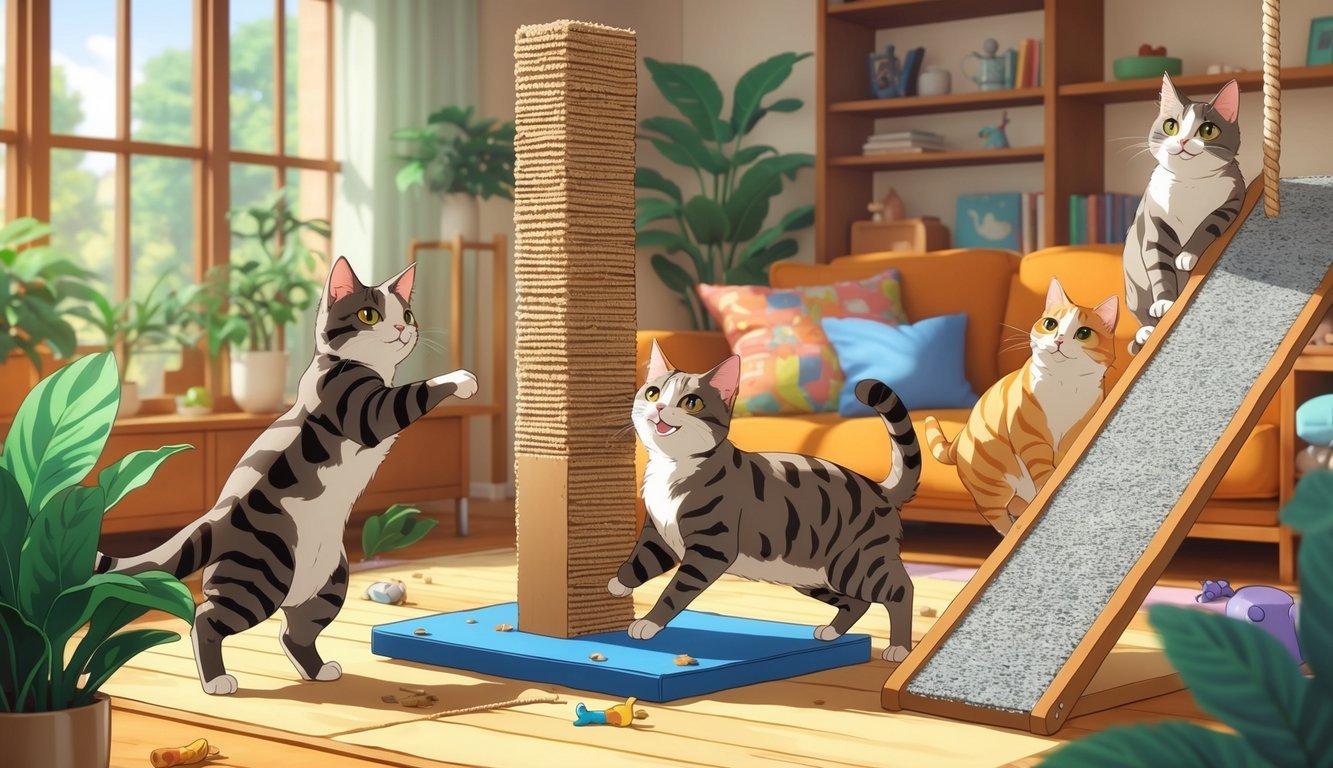
Your cat scratches for more than just keeping their claws sharp. Scratching taps into their instincts, keeps them healthy, and lets them blow off steam in a safe way.
Scratching isn’t a bad habit—it’s just how cats are wired. They use it to mark territory with scent and visual marks, which helps them feel safe at home.
It also gives your cat a way to shake off stress. After something startling, a good scratch can help calm them right down.
Cats love variety. Some go for vertical spots like posts or walls, while others prefer flat surfaces like rugs or cardboard. If you pay attention, you’ll spot their favorites and can steer them to the right scratching outlet.
When you offer good scratching options, you’re not just saving your furniture—you’re meeting an important need in your cat’s daily routine.
Scratching helps keep claws in shape. By pulling and dragging, cats shed old nail layers and avoid overgrown, painful claws.
It’s also a form of exercise. Reaching up to scratch stretches their back, shoulders, and legs, keeping muscles and joints moving.
Scratching even boosts mental health. The activity gives indoor cats something to focus on and helps prevent boredom.
Key benefits include:
When you encourage scratching, you give your cat a healthy, natural way to care for their body and mind.
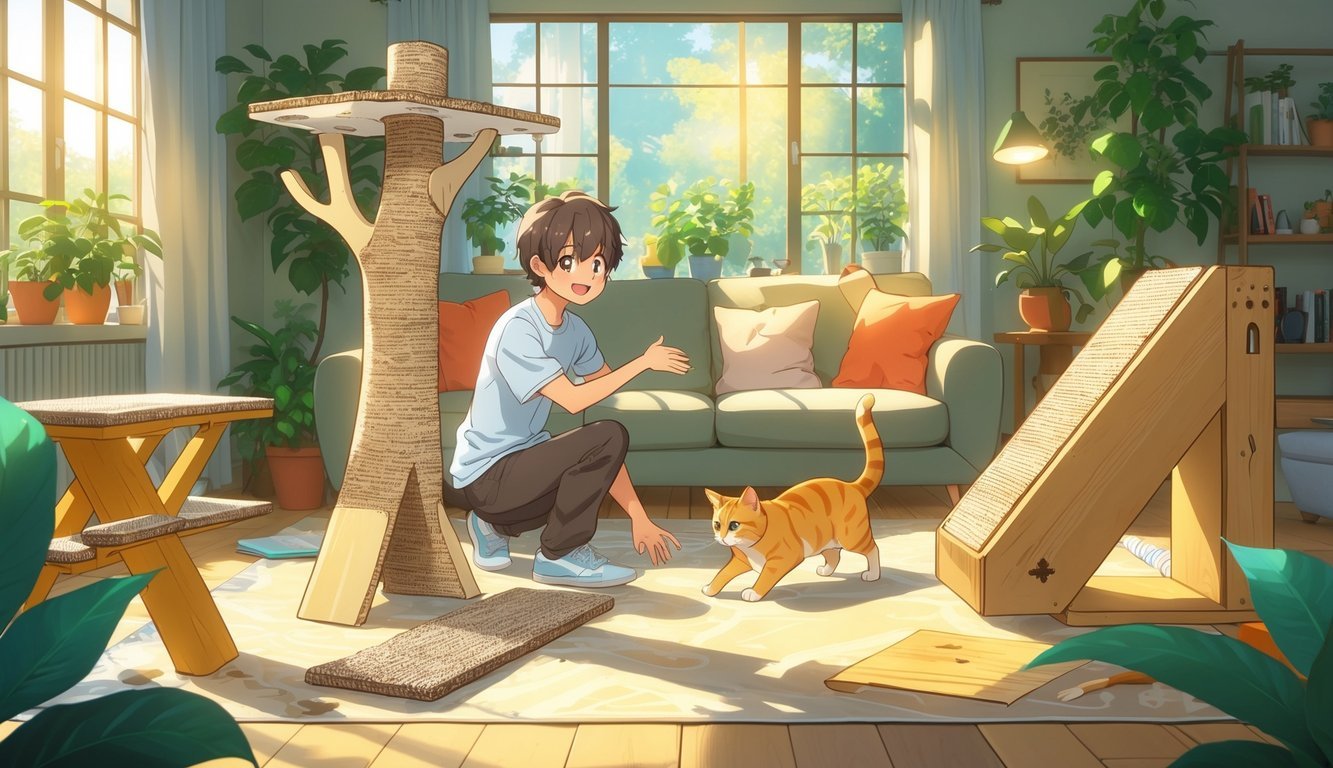
When you bring in new scratching options, you’ve got to guide your cat toward them. Stay consistent when you discourage scratching in places you don’t want.
Watch your cat’s behavior and tweak things as needed. Small changes can make this whole process a lot smoother.
Put the new scratching post or pad right where your cat already scratches. That way, your cat will spot it and might actually use it.
If your cat keeps going for the couch, just set a scratching board next to it. Make it as easy as possible for them to make the switch.
Catnip, silvervine, or treats can make the new scratcher more tempting. Rub some catnip on the surface or toss a favorite toy nearby.
Whenever your cat uses the new scratcher, hand out some praise or a little treat. It’s simple, but it works.
Cats have their own preferences when it comes to scratching. Some love vertical posts, others go for horizontal boards.
Try out both styles and see which one your cat actually likes. You can even swap different scratchers in and out to keep things fresh.
If your cat just ignores the new scratcher, don’t give up. Play with them near it—dangle a toy against the surface and see if they’ll scratch during play.
Eventually, your cat will start to connect scratching with fun and rewards. Isn’t that the goal?
Your cat might keep going back to furniture or walls just because it’s a habit. Try sticking double-sided tape, aluminum foil, or furniture protectors on those spots. These tricks usually make those areas less appealing.
Keep the new scratchers close by so your cat can easily choose them instead. That way, they don’t have to search for the right place.
Some cats really don’t like change. Honestly, patience helps a lot here. Don’t punish them—it just stresses everyone out and usually makes things worse.
When you see your cat scratching in the wrong spot, gently move them to the right one. No need to make a big deal out of it.
If you’ve got more than one cat, you’ll probably need several scratching posts. Put them in different rooms so each cat gets their own space.
This setup helps avoid fights and lets everyone scratch in peace.
The key is sticking with it. The more you show your cat where to scratch and block off the old spots, the sooner they’ll get the idea.